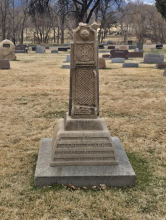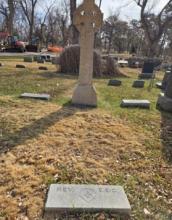A stroll through Evergreen Cemetery is a stroll through a timeline of Victorian funerary and revival-inspired art. Popular in the late 1800s and early 1900s, the Celtic Revival movement witnessed the resurgence of Celtic Art and literature. This included literary masterpieces by notable authors such as William Butler Yeats and Lady Augusta Gregory and artistic representations of the Celtic Cross.
The symbols carved into the stone are more than decorations. They carry deep cultural and historical significance, spanning centuries of Celtic and Christian traditions. The Celtic cross is a unique and instantly recognizable symbol combining a Christian cross with a circle, resulting in a design that features a cross with a ring (known as a "nimbus") around its intersection.
The central cross represents the crucifixion of Jesus Christ, while the circle symbolizes eternity and God’s love, as well as the eternal cycle of life, death, and rebirth. The intersection of the horizontal and vertical arms of the cross signifies the coming together of distinct elements—earth and heaven, life and death, and the physical and spiritual worlds.
Many adventurous souls from England, Ireland, and Scotland arrived in Fountain Colony, aka Colorado Springs, seeking fame, fortune, and a cure for consumption, which earned it the nickname “Lil London.” Carved of sandstone, the Celtic crosses in Evergreen Cemetery have not withstood the elements as well as other monuments made of granite. The following are two stories of those who are interred under these Celtic crosses at Evergreen Cemetery.

James Clark
James was born in Paisley, Scotland, in 1843. He and his brother Norman were visiting Colorado Springs for several weeks for James’ health. The brothers are descendants of James and Patrick Clark, who established the Clark Thread Company in Scotland in 1750.
They received a telegram Sunday morning notifying them of the death of their younger sister in Scotland. Despondent over this sad news, they thought a carriage drive would relieve their sorrow. After leaving the Antlers Hotel, a motorcar spooked their horse, and as the young men attempted to regain control of the horse, James was thrown from the carriage. They took him home, where he died later that evening. The physicians in attendance could find no serious external injuries, and, probably, the shock of the accident and the distressing news of the morning caused a general collapse, resulting in heart failure, as James was already in delicate health. They laid him to rest the next day in Block 17, near author, Helen Hunt Jackson in Evergreen Cemetery. Unfortunately, the original Celtic Cross has broken off and been lost.

The Carrington Family
The Carrington Cross is the cornerstone of the Carrington family lot in Block 54 in Evergreen Cemetery. The Rev Edward Evans Carrington was born in Flintshire, Wales in 1846. He married Lydia Coke and together they made their way to America in 1883. In 1889, they headed west and settled in Colorado Springs. Reverend Carrington was a well- known minister of the Southern Methodist Episcopal Church. Unfortunately, Rev. Harrington died suddenly while on a business trip in Denver, in 1911 at the age of 64. Reverend Carrington’s family stayed in Colorado Springs and were active community members.
Thomas Bernard Evans Carrington, Son of Rev, Carrington, lies buried a short distance south of the family lot in Evergreen Cemetery. Born in Birkenhead, England in 1881, Thomas came to Colorado with his family in 1889 and attended Colorado College in the late 1800s. He turned his attention to the undertaking business and opened Carrington and Sons Undertaking in 1902. The firm was initially comprised of Carrington, his father, and his brother Edward (who passed away in Colorado Springs in 1911 at 37 years of age). As noted in Thomas’s obituary, “he developed his business along modern scientific lines in the care of the dead and in “fact he was most wise, careful and considerate of funeral direction.” We still find entries for Carrington and Sons in our old cemetery ledger books.
